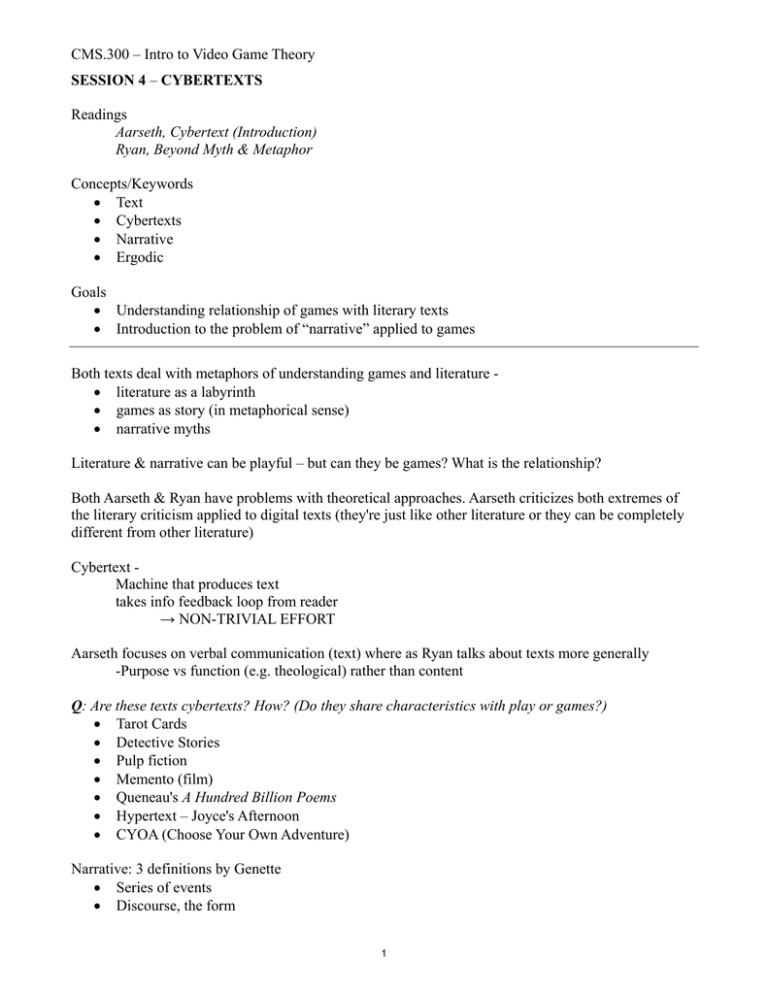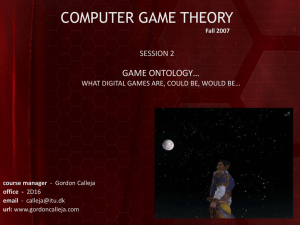CMS.300 – Intro to Video Game Theory Readings Concepts/Keywords
advertisement

CMS.300 – Intro to Video Game Theory SESSION 4 – CYBERTEXTS Readings Aarseth, Cybertext (Introduction) Ryan, Beyond Myth & Metaphor Concepts/Keywords Text Cybertexts Narrative Ergodic Goals Understanding relationship of games with literary texts Introduction to the problem of “narrative” applied to games Both texts deal with metaphors of understanding games and literature literature as a labyrinth games as story (in metaphorical sense) narrative myths Literature & narrative can be playful – but can they be games? What is the relationship? Both Aarseth & Ryan have problems with theoretical approaches. Aarseth criticizes both extremes of the literary criticism applied to digital texts (they're just like other literature or they can be completely different from other literature) Cybertext Machine that produces text takes info feedback loop from reader → NON-TRIVIAL EFFORT Aarseth focuses on verbal communication (text) where as Ryan talks about texts more generally -Purpose vs function (e.g. theological) rather than content Q: Are these texts cybertexts? How? (Do they share characteristics with play or games?) Tarot Cards Detective Stories Pulp fiction Memento (film) Queneau's A Hundred Billion Poems Hypertext – Joyce's Afternoon CYOA (Choose Your Own Adventure) Narrative: 3 definitions by Genette Series of events Discourse, the form 1 CMS.300 – Intro to Video Game Theory The act of telling Other Aspects: A sign with a signifier (discourse) and signified (story) can be told (diegetic) or represented (mimetic) Narrativity level of the signified, medium-free matter of degree Narrative representation: constructed by the reader, based on text World (setting) Individuals (characters) Happenings (actions and events) Myths: (both inspired by fiction!) Aleph: Reordering creates new texts → refer to examples above (Afternoon, Memento) RECONFIGURING NARRATIVE Do lexia in different order provide new narratives? Ex: Memento needs that order, if watched in chronological order there is no surprise VR Narrative/Holodeck: Technologically unviable (advance a bit simulation and abstraction) Holodeck involves a lot of suspension of disbelief, is almost like real life – so what's the point? Show Truffaut’s Fahrenheit 451 – Linda and the TV (“The Family”) Ryan's four types of Interactivity: Internal – user is member of fictional world (1st/3rd person) External – user is outside of fictional world Exploratory – user can move in database but cannot make history or alter the world Ontological – user can make decisions and determine what happens in the world Aarseth's: Interpretive vs. Textonic (adding to the text) Exploratory Ontological External Hypertext Interactive movies CYOA Simulation games (Sim City, Caesar) 2 Internal VR environments Types of plot: mystery story, parallel plot (soap operas), multiple POVs, spatial narrative (traversal), narrative of a place (story of a location) Holodeck Computer games Hypes of plot – quest / fairy tale structure MIT OpenCourseWare http://ocw.mit.edu CMS.300 / CMS.841 Introduction to Videogame Studies Fall 2011 For information about citing these materials or our Terms of Use, visit: http://ocw.mit.edu/terms.




